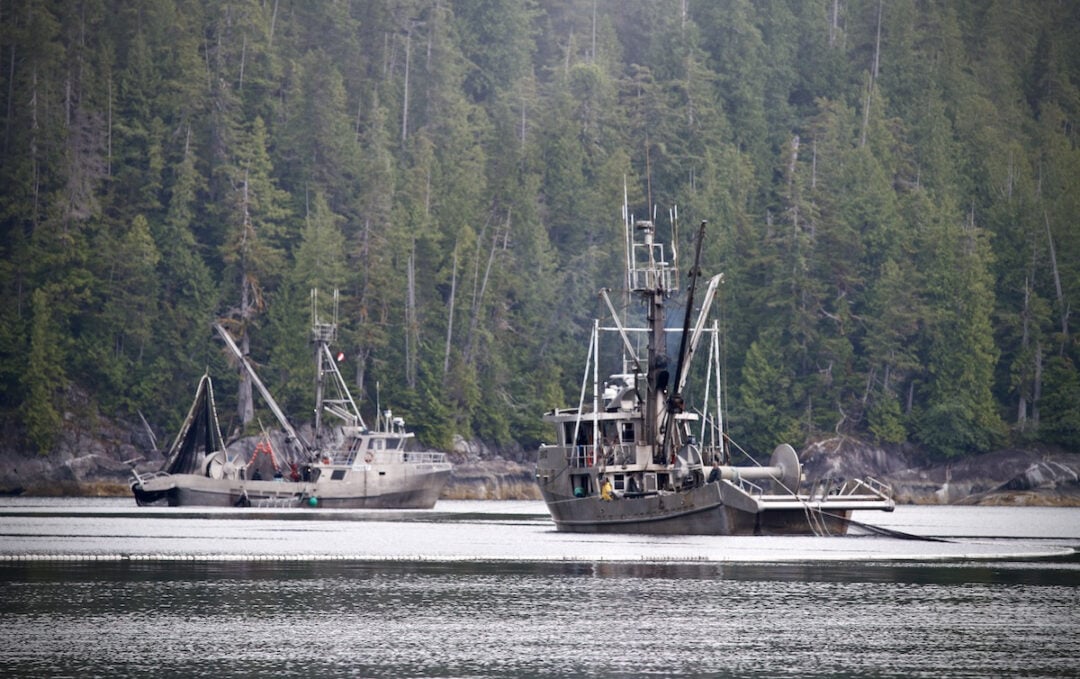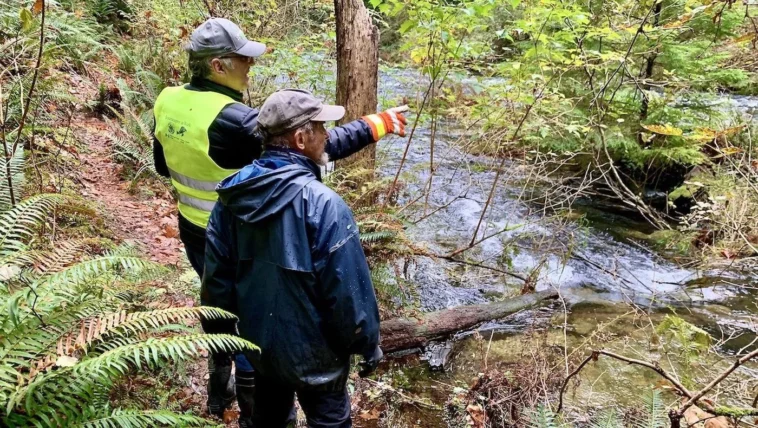by Rochelle Baker, Canada’s National Observer, Local Journalism Initiative, Canada’s National Observer
Fisheries and Oceans Canada cut the monitoring of salmon streams along BC’s North and Central Coast, leaving critical stocks uncounted at the height of spawning season.
Seasonal “creek walkers” — contractors for the fisheries department (DFO) who trek along streams to record salmon returns — haven’t been hired as stocks return along the coast from Bella Bella to the Alaskan border, including major watersheds like the Skeena, Nass and Kitimat systems, says a coalition of conservation groups.
Assessing returns to key streams is critical for estimating stocks, managing fisheries and conservation, said Misty MacDuffee, wild salmon program director at Raincoast Conservation Foundation.
“Some of these streams have been walked for decades, so the power of seeing and understanding historical [salmon] trends is being lost as well.”
Misty MacDuffee, Wild Salmon Program Director at Raincoast Conservation Foundation
“Not having contracts in place as salmon are returning to rivers is unprecedented,” she said. “Budget cuts have always been a factor, but never this extreme.”
If contracts are cancelled, an information gap occurs that also compromises long-term analysis of salmon populations, MacDuffee said.
“It’s not like you can just bring someone else in to do this job [at short notice].”
Misty MacDuffee, Wild Salmon Program Director at Raincoast Conservation Foundation
“Some of these streams have been walked for decades, so the power of seeing and understanding historical [salmon] trends is being lost as well.”
Stream walkers also monitor the same set of waterways every year and possess an “unbelievable reservoir of knowledge,” she added.
“It’s not like you can just bring someone else in to do this job [at short notice].”
It’s not clear if stream walkers in other areas of the province are also being impacted, MacDuffee said.
DFO being ‘downright deceptive’
The DFO, headed by minister Joanne Thompson, offered little clarity before Canada’s National Observer’s publication deadline, in response to specific questions about stream-walker contracts or salmon-monitoring activities along the North Coast.
“No significant changes to core Pacific salmon stock assessment and monitoring programs have been implemented this season,” the ministry wrote. The department provided no other details specific to the issue.
“It’s a dishonest response, unless you consider shutting down the ground stock assessments of salmon streams across most of the North Coast of BC — during the height of the spawning season — to be ‘insignificant.’”
Aaron Hill, Executive Director of the Watershed Watch Salmon Society
DFO’s answer is deceptively vague, said Aaron Hill, executive director of the Watershed Watch Salmon Society.
“It’s a dishonest response, unless you consider shutting down the ground stock assessments of salmon streams across most of the North Coast of BC — during the height of the spawning season — to be ‘insignificant,’” Hill said.
There are only a handful of stream walkers left on the North Coast who, due to budget cuts and unrenewed contracts as people retire, have taken on more and more surveys with fewer resources over the years, he added.
There is an effort being made, often with help from the stream walkers themselves, to have First Nations Guardians take over monitoring in their territories, Hill said. However, the handover process hasn’t been completed.
“That transition needs to happen in an intentional and careful manner to make sure we have continuity of data for all of our salmon streams,” he said. “But what’s happening here is just an absolute mess.”
DFO’s latest lapse is part of the ongoing legacy of neglect of its core responsibility to properly monitor salmon stocks, particularly on the North Coast, Hill said.
Pacific Salmon monitoring at all-time low
Stock monitoring has fallen to an all-time low under the Liberal government despite the conservation crisis faced by most Pacific salmon stocks, recent research from the University of Alberta shows.
In the past decade, nearly two-thirds of historically monitored salmon returns from the Yukon to southern BC have no reported spawn estimates between 2014 to 2023 — the worst decade for data since broad scale surveys began in the 1950s, according to the study.
The monitoring of salmon, with 6,973 unique populations, reached its peak in the mid 1980s before steadily declining. There is only spawning data recorded for 37 per cent of those populations in the past decade, down from nearly 69 per cent at the peak of monitoring.
Coho and chum salmon saw the greatest drops in monitoring, especially on Vancouver Island, BC’s Central Coast and inlets, and in Haida Gwaii. Pink salmon also saw major monitoring reductions on the Central Coast, Skeena and Haida Gwaii.
As commercial fisheries contract, using catch data for analysis is increasingly ineffective to track changes in overall salmon abundance across various populations, the University of Alberta study said — so monitoring must shift onshore, especially to track changes or resilience to stressors like habitat destruction and climate change.
The ongoing failure to monitor North Coast stocks means less access to salmon for First Nations food fisheries and the commercial sector, Hill said.
Salmon fishers eco-certification sunk

The commercial salmon fishing sector has taken serious blows due to DFO’s poor stock monitoring, said Christina Burridge, executive director of the BC Seafood Alliance.
Canada’s Pacific salmon fishery was forced to withdraw from the Marine Stewardship Council (MSC) certification program in 2019, as a result of insufficient DFO data to assess salmon abundance trends due to monitoring declines of salmon streams on the central and northern coasts, poor bycatch data and understanding of the impacts of hatchery fish on wild stocks.
DFO failed to develop a promised plan for North Coast salmon stock assessment in the five years prior to the sector withdrawing from the eco-labelling program, Burridge said. What’s more, little progress on the plan has been made since.
The BC Salmon Marketing Council argues the issue is a lack of good data collection by DFO, rather than unsustainable fishing practices. However, the industry continues to pay the price, Burridge said.
The MSC eco-certification loss means significantly lower prices for fish harvesters, she said.
Higher-price species, such as sockeye, face discounts between $1 to $3 USD per pound. Pink salmon losses alone between 2020-22 led to revenue drops of approximately $3 million USD for the sector.
Worse, many big retailers, such as Costco, require sustainability ratings and will not buy certain salmon stocks at any price, substituting Alaskan MSC salmon at the expense of Canadian fish, she said.
There are continued concerns about DFO’s lack of transparency around stream-monitoring efforts and data, and the potential for more budget cuts to essential programs under pending federal austerity measures, Hill said.
“These essential programs need to stay in place. We don’t need more bureaucrats in Ottawa at DFO. We need people on the ground.”
Aaron Hill, Executive Director of the Watershed Watch Salmon Society
The federal government spent nearly $650 million over the past five years on its Pacific Salmon strategy initiative to save plummeting stocks, but can’t find the funds to monitor salmon returns, which is the “backbone” of their mandate, Hill said.
“They’ve spent millions on all manner of things to conserve and restore wild salmon in BC, and now they don’t have money for the most important job they have as a fishery management agency,” he said.
“These essential programs need to stay in place. We don’t need more bureaucrats in Ottawa at DFO. We need people on the ground.”
He had a key request for the ministry.
“Just count the damn fish!”




